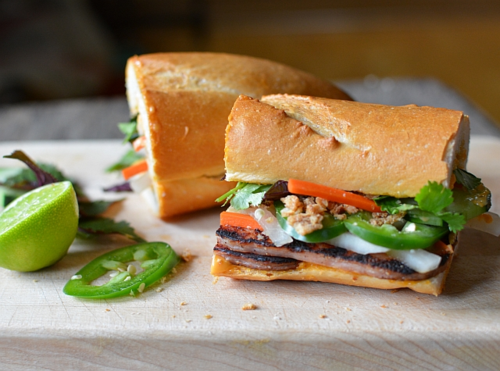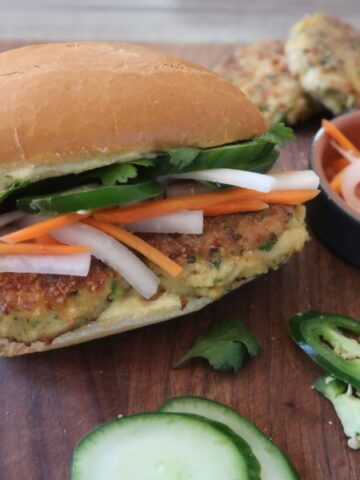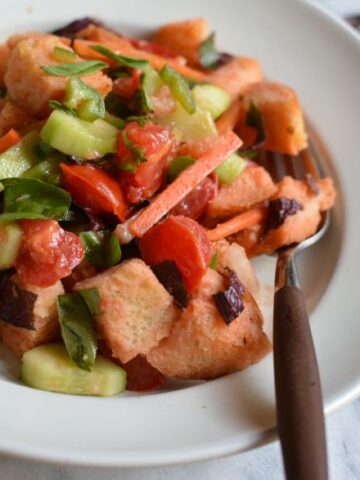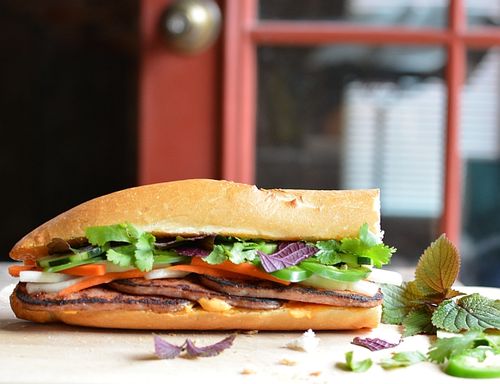
I went to the supermarket to buy a can of Spam. The canned meat section was pretty tidy except for where the Spam was. It was unruly and about half empty. I was flummoxed, not so much by the run on Spam, but by the variety of it. The last time I used Spam was in the mid-1990s, as a joke appetizer for a Spam-loving friend’s birthday: I made Spam turnovers and he and his Beverly Hills hairdresser pals loved them.
Since then I’d missed out on all the changes in the world of Spam. It is nowadays super varied to smartly target different diets (low sodium or low-cal), ethnic interests (teriyaki, black pepper, and jalapeno) and porky interests (hickory/bbq or bacon). The recipes on the back of the Spam cans featured a lot of sandwiches.
The marketing people at Hormel, the parent company of Spam, know what many people want to eat, especially Asians. About half of Hormel’s production is exported overseas, especially to places where U.S. military installations are, or used to be. According to Forbes.com in a 2013 story, “Spam is a delicacy in countries like China, a staple in Korea and the Philippines and practically the national dish of Guam. As these countries put more meat on their tables, Spam represents an exotic import with a long shelf life and fewer jokes to hold back consumption.”
I bought a can of regular and black pepper Spam. My aim was to make banh mi. Spam banh mi is not a go-to rendition, despite the U.S. military involvement in Vietnam. However, I’d seen a recipe in Roy Choi’s L.A. Son cookbook; his sandwich is being served in Koreatown’s Eat at Pot, a very cool new spot in Los Angeles. He was inspired by a banh mi from Little Saigon in Orange County, California. Somewhere along the line, someone tweeted a Spam and fried egg banh mi from Little Saigon. How hard could it be?
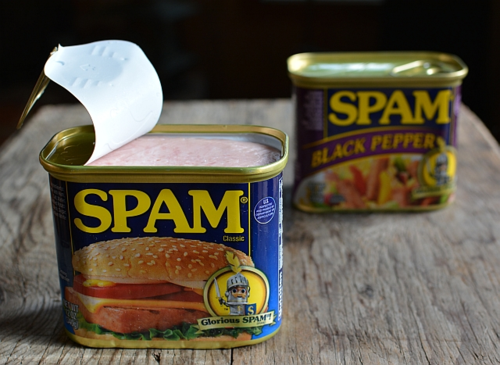
Over the weekend on Facebook, Mike in Guam confirmed that the island is teaming with Spam fans. There were folks who commented that Spam was disgusting. Leanne said her dad sliced Spam and deep-fried the pieces. Should I make Spam banh mi? Why not? Banh mi is often made with processed meat, Jordan said. Spam gets a unfair bad rap, Jennifer remarked. Norio, who deemed Spam delicious and seemed to be quite versed in using it, suggested thinly slicing it; the photo of Choi’s banh mi had too thick of pieces.
I kept all of that in mind when I found myself looking at the can of pink pork product. I thinly sliced part of the block and fried it with some seasonings to give it Southeast Asian twists:

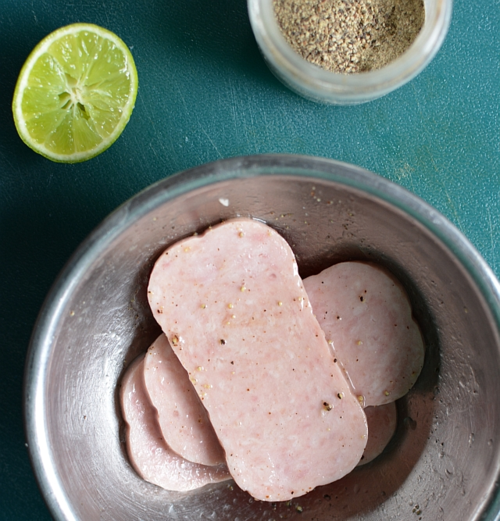
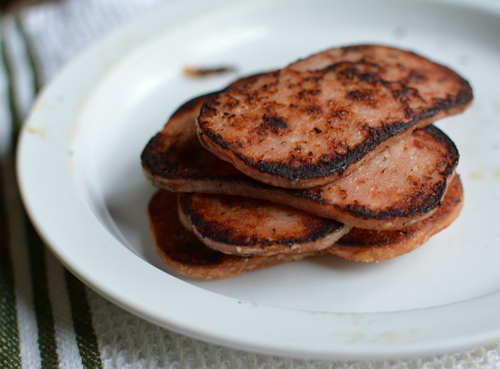
I assembled a banh mi with cilantro as well as tia to (red/purple perilla) plucked from the garden. Loaded with homemade sriracha aioli and daikon pickle, and all the other banh mi accoutrements, the sandwich sort of sucked. Salty, dead, leaden flavors. Note to self and to you: Buy low-sodium Spam if you're going to fry it. The frying intensifies the salt and spices to the point where the Spam overwhelms other elements in the sandwich.
There were few discernable highs and lows. Little nuance. I added a squeeze of lime. Nothing. How about a sprinkling of canned fried onions (it worked for Thanksgiving leftover banh mi so maybe it would fix things here). Blah. Major banh mi disappointing.
I called my mom. We chatted about Spam and other things -- just in case you think that I may super obsessed. Ha.)
“Why didn’t we eat it?” I asked her. It sort of tastes like a strange French pate or Vietnamese cold cut.
My mom hesitated, then flatly said, “If we got a can of Spam, we made banh mi with it. It was an American food for soldiers.”
Spam was an American PX food, she then explained. It was not an imported food marketed and sold to those who could afford it. Some of the women who married American soldiers would buy it from the PX then resell it. So it was basically a black market item.
“You’d call that a black market?” my mom responded. To her, it was just a way for people to make a little extra money, commercial trading Viet style. Good point. In 1970s Saigon, Spam was more of a grey market item than a black one; grey markets involve legal but unofficial and unauthorized transactions.
My Spam banh mi was still not what it was suppose to be. I went back into the kitchen. This time, I decided to treat spam like a Vietnamese cold cut, like a Vietnamese cook would do. I sliced it super thin to allow its saltiness to spread around better, just like I would with gio lua/cha lua Vietnamese silky sausage.
For the second round of banh mi, I classed up the Spam. Many people want to keep Spam down as low-brow food, a Monty Python skit. But for my family in 1970s Saigon, Spam was more of a canned meat novelty. We had Vietnamese charcuterie that my mom felt was superior. Spam wasn’t a beloved cult food like Maggi seasoning sauce, Bretel butter and canned pate.
But that didn’t mean that I couldn’t try treating Spam like an exotic product in my kitchen. So brought out the Maggi Arome, butter and canned pate. I sliced the Spam super thin and made a dac biet sandwich: Butter, mayo, Maggi (on the top only because Spam is super salty), pate, black pepper, Spam, daikon and black pepper, chile, cucumber, and cilantro.
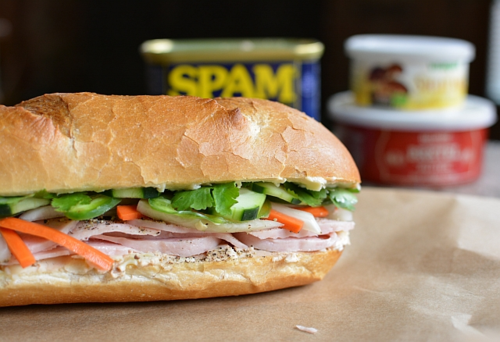
It was much brighter and more vibrant than the banh mi made with fried Spam. Sometimes you don’t want to fuss up a sandwich too much. The Spam has already been manipulated and finely tuned to the needs of Hormel products. Any attempt to tweak it to be other than what it was intended to be was useless in this situation. Sometimes you should just let food be.
Compared to a dac biet banh mi that I make from Vietnamese charcuterie, the Spam rendition was good though not better or brilliant. I imagine that if you grew up with Spam and it was one of your nostalgic foods, or if you had limited fresh pork options around, Spam can, could and would do a lot in your kitchen.
If you’re a Spam fan, what do you do with it?
Related links:













